|
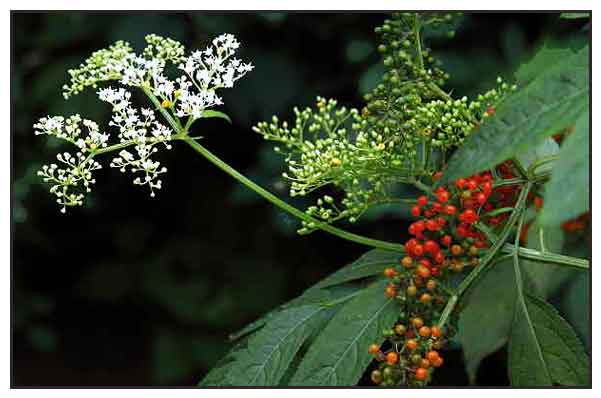 Gen info Gen info
- Sambucus is a genus with 5 to 30 species of shrubs or small trees. Formerly in the honeysuckle family, Caprifoliaceae, it was reclassified and placed into the moschatel family, Adoxaceae. Two of the species are herbaceous. Sauko is sometimes called the "bridal bouquet."
-
Sambucus javanica, the Chinese elder, is a species of elderberry in the family Viburnaceae, native to subtropical and tropical Asia.
- Etymology: The genus name Sambucus derives from the Ancient Greek word sambuke, an ancient wind instrument, relating to the removal of pith from twigs to make whistles. (14) The specific epithet javanica refers to the plant's geographic origin or distribution.
Botany
• Sauko is a shrub or
small, widely spreading tree up to 4 meters in height. Leaves have 3 to 8 pairs of opposite leaflets and a terminal
leaflet. Leaflets are thin, oblong-lanceolate, 5 to 20 centimeters long, 1.3 to 5 centimeters wide, pointed
at both ends, toothed on the margins. Flowers are small, cream-white, on terminal clusters (compound
umbels), 15 to 30 centimeters wide.
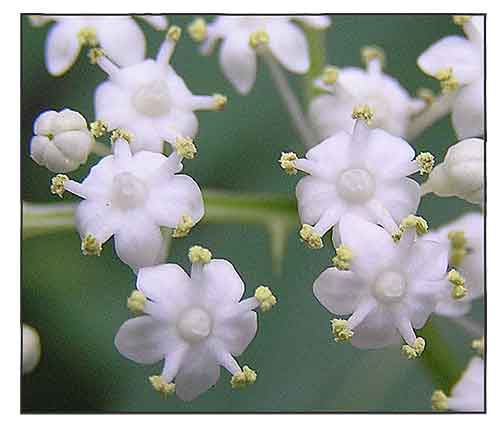 • Growth form: A shrub about 1 – 3 m tall. Foliage: Leaves are pinnate with recurved (rarely foliaceous) stipules between the nodes. Leaflets occur in 2 – 6 pairs, each about 6 – 22 cm long and 1.5 cm to 6.5 cm wide. Leaflets are oblong to linear lanceolate; margin serrulate and often with 1 to several glandular-swollen teeth. Apex long acuminate while base is obtuse and oblique. Young leaflets sparsely pubescent. Terminal leaflets (rarely) adnate to lower leaflets. Mid rib and base of side nerves are hairy on upper leaflet surfaces while hairy or glabrous underneath the leaflets. Stems: Stem is striate and lenticels are inconspicuous. Flowers: Inflorescence occurs at the terminal as umbellate cymes, with foliate base. A few of inflorescence are aborted to form a flat top shape. Some flowers are modified into (often) yellow nectaries. Corolla is white or creamy with 5 lobes (each about 1.5 – 3.5 mm long). Calyx tube is urceolate. Filaments and anthers (yellow or purple) are about the same length and not exceeding corolla length. Fruit: Fruit is ovoid (about 3-4 mm wide) and usually consist of 3 seeds (about 2 mm long). (Flora & Fauna Web) • Growth form: A shrub about 1 – 3 m tall. Foliage: Leaves are pinnate with recurved (rarely foliaceous) stipules between the nodes. Leaflets occur in 2 – 6 pairs, each about 6 – 22 cm long and 1.5 cm to 6.5 cm wide. Leaflets are oblong to linear lanceolate; margin serrulate and often with 1 to several glandular-swollen teeth. Apex long acuminate while base is obtuse and oblique. Young leaflets sparsely pubescent. Terminal leaflets (rarely) adnate to lower leaflets. Mid rib and base of side nerves are hairy on upper leaflet surfaces while hairy or glabrous underneath the leaflets. Stems: Stem is striate and lenticels are inconspicuous. Flowers: Inflorescence occurs at the terminal as umbellate cymes, with foliate base. A few of inflorescence are aborted to form a flat top shape. Some flowers are modified into (often) yellow nectaries. Corolla is white or creamy with 5 lobes (each about 1.5 – 3.5 mm long). Calyx tube is urceolate. Filaments and anthers (yellow or purple) are about the same length and not exceeding corolla length. Fruit: Fruit is ovoid (about 3-4 mm wide) and usually consist of 3 seeds (about 2 mm long). (Flora & Fauna Web)
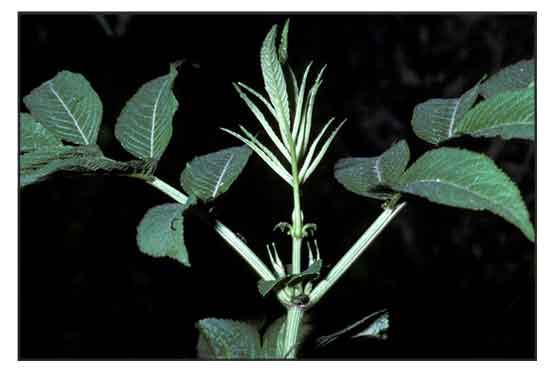 Distribution Distribution
- Native to the Philippines.
-
In primary forests, chiefly at medium altitudes, ascending to 2,000
meters.
-
Also occurs in old clearing, damp thickets, etc.
-
In most or all provinces of Luzon,
Mindoro, Catanduanes, Leyte, Negros, Panay, Mindanao.
- Also native to Afghanistan, Assam, Bangladesh, Borneo, Cambodia, China North-Central, China South-Central, China Southeast, East Himalaya, Hainan, Japan, Jawa, Kazan-retto, Korea, Laos, Lesser Sunda Is., Myanmar, Nansei-shoto, Nepal, New Guinea, Ogasawara-shoto, Pakistan, Philippines, Sulawesi, Sumatera, Taiwan, Thailand, Tibet, Vietnam. ( 9)
Constituents
- Roots reported to contain chlorogen acid.
- Study yielded flavonoids, phenolics, and alkaloids.
- Study on Sambucus chinensis yielded 5 compounds: beta-sitosterol, oleanolic acid, ursolic acid, kaempferol-3-O-beta-D-(6-O-acetylglucopyranosid)-7-O-beta-D-glucopyranoside, and kaempferol-3-O-beta-D-glucopyranosid-7-O-beta-D-glucopyranoside. (10)
- A study of four elderberry species and eight hybrid yielded 19 different anthocyanins using HPLC-MS. The prevalent anthocyanin in S.javaniva hybrids was identified cyanin-3(E)-p-coumaryl-sambubioside-5-glucoside. The highest content of total analyzed anthocyanin (TAA) was determined in berries of the interspecific hybrid S. javanica x S. racemosa, followed by S. nigra, (S. javanica x S. nigra) x cv. Black Beauty, and (S. javanica x S. nigra) x S. cerulea. (12)
- Study of aerial parts of S. javanica isolated a new triterpene, javablumine A (1) along with six known ones, identified as 3β,23-dihydroxy-11α,12α-epoxy-urs-20(30)-en-28,13β-olide (1), ursolic acid (2), pomolic acid (3), oleanic acid (4), 2α-hydroxy-oleanolic acid (5), α-amyrin (6), and lupeol palmitate (7), respectively.(see study below) (20)
Properties
- Crushed twigs and leaves are rather foetid.
-
Acidic-tasting, neutral-natured.
- Depurative, diuretic, discutient, emetic, alterative, emollient, purgative, rubefacient.
- Root antirheumatic, antiphlogistic, soothes muscles and invigorates
circulation.
- Stem and leaves sudoforic and diuretic.
- Studies have suggested anticancer, hepatoprotective, immunomodulatory, osteoprotective, hematopoietic, anti-inflammatory, antioxidant, antimicrobial properties.
Parts used
· Roots, leaves,
and stem.
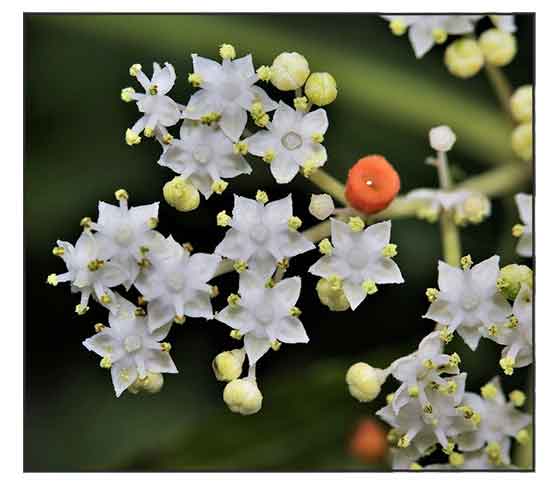 Uses Uses
Edible
- Fruits, raw or cooked.
- Flowers, raw or cooked.
- Leaves and young stems, cooked.
- Roots, cooked.
Folkloric
· In Mindanao the plant is considered a remedy for fatigue.
· Leaves and roots
used for diseases of the bones, rheumatic complaints, pains and paresthesias.
Boil leaves, bark, berries and flowers (40 g) to a pint of boiling water;
drink the tea twice daily. Also used for coughs, tonsillitis, asthma.
· Decoction of fruit used for injuries, skin diseases and swellings.
· In Indo-China used as depurative, diuretic and purgative.
· Poultice of leaves, berries and flowers can be applied to aching
parts; also, for breast swelling
· Rheumatic muscular and bone pains, sprains: use 30 to 60 gms
dried roots in decoction.
· Nephritis-edema, beriberi edema: use 12 to 25 gms drug material
from entire plant in decoction.
· Pruritus: use decoction of entire plant applied as external
wash.
· In China, decoction used for hepatitis,
infectious diarrhea and tonsillitis.
· In old Chinese medical books, recorded for treatment of bruises, rheumatism, blood circulation and for detoxification and anti-inflammatory effect. (24)
· Leaves, stems and roots used for treatment of wounds.
· In Indonesia, used to relieve pain, reduce swelling and improve the circulation. Used for beri-beri, jaundice, chronic rheumatism.
- In Malaysia, leaves are crushed with water and applied on inflamed parts to reduce pain and inflammation. (11)
- In Lao, reputed to increase fertility. Among the Hmong,
leaves are used to make plaster for fractures and edema. Root decoction drunk in the belief that it alleviates malaria attacks.
(15)
- In northern Thailand, used for healing bone fractures.
- In Vietnam, the Mien people use leaves and stems used for treatment of fatigue and sprains. (23)
Others
· In Mindanao the
Toxicity concerns
: Although no toxicity has been reported for this species, some members of the genus have reported toxicity with leaves, seeds, stems and roots, attributed to a cyanide producing glycoside. Ingested in sufficient amounts, a toxic build up of cyanide may occur. Fruits of other species have been reported to cause stomach upsets. Any toxin the fruit might contain is likely of low toxicity destroyed with cooking.
Studies
• Shuodiao / Hepatoma and Pancreatic Cancer Combination Medication: 5-9% constituent of a medicine preparation being studied for hepatoma and pancreatic cancer, derived from the young branches and leaves of the Chinese plant Shuodiao. (4)
• Chemical Constituents: Study of S. chinensis isolated 5 compounds: beta-sitosterol, oleanolic acid, ursolic acid,kaempferol-3-O-beta-D-(6-O-acetylglucopyranosid)-7-O-beta-D-glucopyranoside, and kaempferol-3-O-beta-D-glucopyranosid-7-O-beta-D-glucopyranoside. (6)
• Hepatoprotective: Extraction of S. chinensis by 75% alcohol showed very significant protective effect on mice against acute hepatic injury induced by carbon tetrachloride. (7)
• Immunomodulatory / DMBA-Toxicity / Berries and Leaves: Study evaluated the immunomodulatory activities of Sambucus javanica extracts in 7,12-dimethylbenz[a] anthracene (DMBA)-treated BALB/c mouse. DMBA was administered at 2.8 mg/kbw 10 times over a month. Mice were treated with Sj berries and leaves extracts for 2 weeks. Increased expression of TNF-α and IFN-γ by DMBA were significantly decreased after treatment with berries and leaves extracts. Necrosis incidence was also diminished with Sambucus javanica treatment. Results suggest extracts have immunomodulatory activities to suppress inflammation and reduce necrosis incidence in experimental mice. (16)
• Osteoprotective / Leaves: Study evaluated the potential of crude extracts and fractions of leaves for osteoporotic protection. Phytoconstituent analysis showed crude water and crude ethanol extracts contained gallic acid, rutin, and chlorogenic acid as major compounds. The extracts stimulated osteoblastic cell differentiation and enhanced osteoprotective activity, evidenced by significant increase in ALP activity, OC, OPG, and OPG/RANKL ratio, and the degree of calcification. Also, they exhibited a negative impact on bone resorption by significantly reducing RANKL and ROS production. Results suggest potential as natural active pharmaceutical ingredient for development of bone health products. (17)
• T-Cells Regulation Modulation in DMBA-Exposed / Leaves: Study evaluated the effects of Sj leaves extracts toward T cells regulation in 7,12-dimethylbenzene (a) anthracene (DMBA)-exposed mice. DMBA induction decreased the relative number of CD4+CD25+CD62L+ cells while leaves extract of S. javanica significantly increased their expression. Leaves and berries extracts also sharply suppressed expression of CD4+CD62L+ cells. Results suggest Sj extract medicinal properties may be due to modulation of T cells regulation in DMBA-induced mice. (18)
• Hematopoietic / Berries and Leaves: Hematopoiesis is pivotal in the maintenance of body homeostasis. Chemicals, drugs, and various environmental factors can lead to severe bone marrow failure, for which stem cell transplantation and immunosuppression remain ineffective. Study evaluated the hematopoiesis potency of berries and leaves extracts in chloramphenicol (CMP)-induced aplastic anemia mice model. Results showed hematopoiesis activity suggested by berries and extracts that significantly promoted blood progenitor cells such as TER-119+ VLA-4+ erythrocytes lineage and Gr-1+ granulocytes after exposure to CMP. (19)
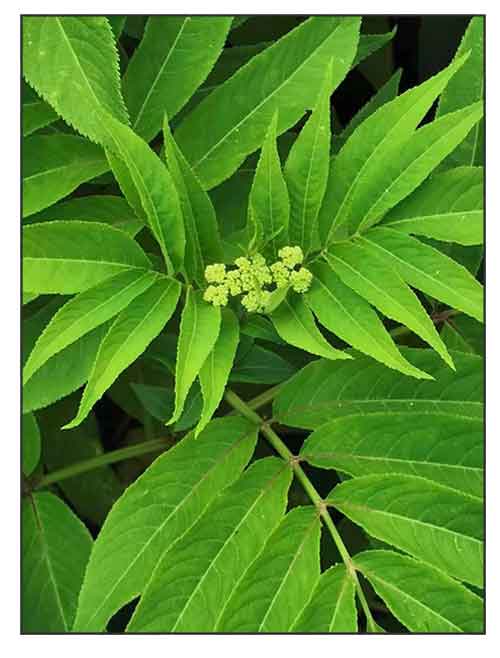 • Bioactive Triterpenoids / Aerial Parts: Study of aerial parts of S. javanica isolated a new triterpene, javablumine A (1) along with six known ones, Compounds 1 and 3, 3β,23-dihydroxy-11α,12α-epoxy-urs-20(30)-en-28,13β-olide and pomolic acid, exhibited inhibitory effects against nitric oxide (NO) production in lipopolysaccharide (LPS)-activated RAW264.7 macrophage cell lines with IC50s of 17.4 and 26.2 µM, respectively. (see constituents above) (20) • Bioactive Triterpenoids / Aerial Parts: Study of aerial parts of S. javanica isolated a new triterpene, javablumine A (1) along with six known ones, Compounds 1 and 3, 3β,23-dihydroxy-11α,12α-epoxy-urs-20(30)-en-28,13β-olide and pomolic acid, exhibited inhibitory effects against nitric oxide (NO) production in lipopolysaccharide (LPS)-activated RAW264.7 macrophage cell lines with IC50s of 17.4 and 26.2 µM, respectively. (see constituents above) (20)
• Antimicrobial / Antioxidant / Flowers and Fruits: Study showed flower and fruit extracts of Sambucus javanica have antimicrobial activity with ZOI of 11.9 mm and 13.7 mm against E. coli and S. aureus. MIC against E. coli and S. aureus was 12.5%. The highest antioxidant activity was with the fresh fruit extract with IC50 of 58.74 µg/mL. (21)
• Immunomodulatory in Chloramphenicol-Induced Aplastic Anemia Model / Leaves and Berries: Study evaluated the immunomodulatory activities of S. javanica in chloramphenicol-induced aplastic anemia mouse model. Results showed the extracts could promote the population number of regulatory T-cells and naive cytotoxic T-cells, and reduce the inflammation and necrotic incidence in CMP-induced mouse aplastic anemia model. (22)
Availability
Wild-crafted.
Ornamental cultivation. |


 Distribution
Distribution
